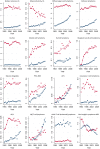Differences in incidence and trends of haematological malignancies in Japan and the United States
- PMID: 24245986
- PMCID: PMC3907701
- DOI: 10.1111/bjh.12659
Differences in incidence and trends of haematological malignancies in Japan and the United States
Abstract
The incidence of a malignant disease reflects the genetic and cumulative exposure to the environment of a population. Therefore, evaluation of the incidence and trends of a disease in different populations may provide insights into its aetiology and pathogenesis. To evaluate the incidence of haematological malignancies according to specific subtypes, we used population-based registry data in Japan (N = 125 148) and the United States (US; N = 172 925) from 1993 to 2008. The age-adjusted incidence of haematological malignancies in Japan was approximately one-half that in the US but has been increasing significantly, whereas no significant change was seen in the US [annual percent change (95% C confidence interval): Japan, +2·4% (1·7, 3·1); US, +0·1% (-0·1, 0·2)]. Hodgkin lymphoma (HL) and non-Hodgkin lymphoma (NHL) showed the largest differences in incidence, with the most remarkable differences observed for chronic lymphocytic leukaemia, HL-nodular sclerosis, mycosis fungoides and cutaneous T-cell lymphoma. HL and NHL are increasing substantially in Japan but not in the US, suggesting that environmental exposures, such as Westernization of the life style may be causing this increase. Differences in the incidence and trends for specific subtypes also showed a marked contrast across subtypes, which, in turn, may provide significant new insights into disease aetiology in the future.
Keywords: Japan; haematological malignancies; incidence; surveillance epidemiology and end results; trend.
© 2013 The Authors. British Journal of Haematology published by John Wiley & Sons Ltd.
Figures


Comment in
-
Subtype-specific incidence rates of lymphoid malignancies in Hong Kong compared to the United States, 2001-2010.Cancer Epidemiol. 2016 Jun;42:15-23. doi: 10.1016/j.canep.2016.02.007. Epub 2016 Mar 15. Cancer Epidemiol. 2016. PMID: 26991956
References
-
- Anderson JR, Armitage JO. Weisenburger DD. Epidemiology of the non-Hodgkin's lymphomas: distributions of the major subtypes differ by geographic locations. Non-Hodgkin's Lymphoma Classification Project. Annals of oncology. 1998;9:717–720. - PubMed
-
- Bray F, Guilloux A, Sankila R. Parkin DM. Practical implications of imposing a new world standard population. Cancer causes & control: CCC. 2002;13:175–182. - PubMed
-
- Centers for Disease Control and Provention (CDC) HIV surveillance–United States, 1981-2008. MMWR. Morbidity and mortality weekly report. 2011;60:689–693. - PubMed
Publication types
MeSH terms
Grants and funding
LinkOut - more resources
Full Text Sources
Other Literature Sources

